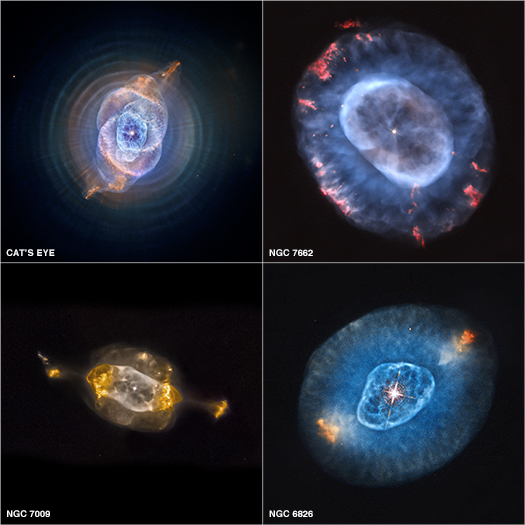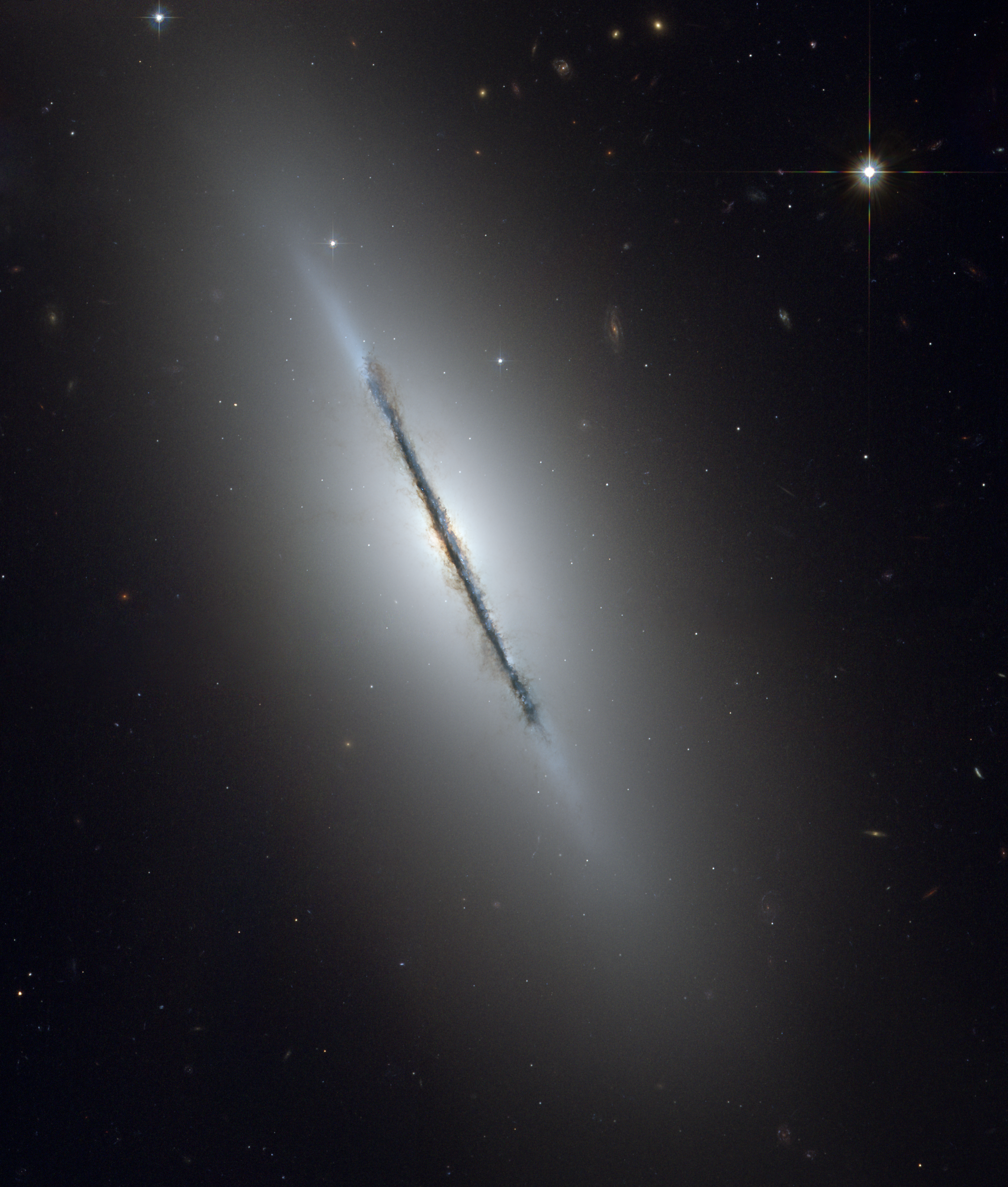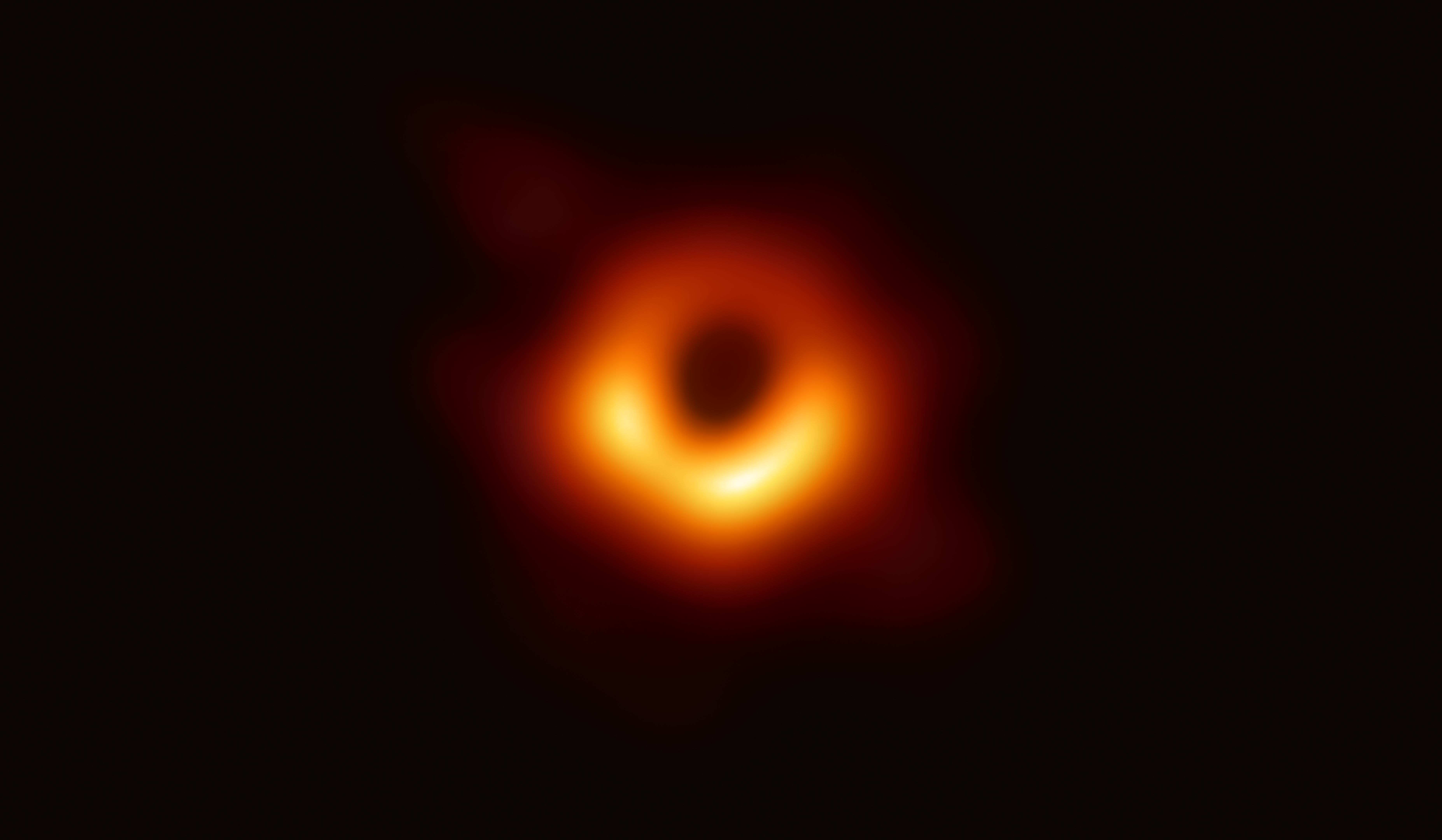|
NGC 2787
NGC 2787 is a barred lenticular galaxy approximately 24 million light-years away in the northern constellation of Ursa Major. It was discovered on December 3, 1788 by German-born astronomer William Herschel. J. L. E. Dreyer described it as, "bright, pretty large, a little extended 90°, much brighter middle, mottled but not resolved, very small (faint) star involved to the southeast". The visible galaxy has an angular size of and an apparent visual magnitude of 11.8. This galaxy is small and isolated with a morphological classification of SB(r)0+, which indicates a barred spiral (SB) with a ring around the bar (r). Being a lenticular galaxy, it has the large halo of an elliptical galaxy. The disk is inclined at an angle of to the line of sight from the Earth, with the major axis aligned along a position angle of . The galaxy has an unusually high mass-to-light ratio, much greater than for a typical spiral galaxy. The distribution of the galaxy's neutral hydrogen forms a ... [...More Info...] [...Related Items...] OR: [Wikipedia] [Google] [Baidu] |
New General Catalogue
The ''New General Catalogue of Nebulae and Clusters of Stars'' (abbreviated NGC) is an astronomical catalogue of deep-sky objects compiled by John Louis Emil Dreyer in 1888. The NGC contains 7,840 objects, including galaxies, star clusters and emission nebulae. Dreyer published two supplements to the NGC in 1895 and 1908, known as the ''Index Catalogues'' (abbreviated IC), describing a further 5,386 astronomical objects. Thousands of these objects are best known by their NGC or IC numbers, which remain in widespread use. The NGC expanded and consolidated the cataloguing work of William and Caroline Herschel, and John Herschel's ''General Catalogue of Nebulae and Clusters of Stars''. Objects south of the celestial equator are catalogued somewhat less thoroughly, but many were included based on observation by John Herschel or James Dunlop. The NGC contained multiple errors, but attempts to eliminate them were made by the ''Revised New General Catalogue'' (RNGC) by Jack W. Sulent ... [...More Info...] [...Related Items...] OR: [Wikipedia] [Google] [Baidu] |
Galaxy Morphological Classification
Galaxy morphological classification is a system used by astronomers to divide galaxies into groups based on their visual appearance. There are several schemes in use by which galaxies can be classified according to their morphologies, the most famous being the Hubble sequence, devised by Edwin Hubble and later expanded by Gérard de Vaucouleurs and Allan Sandage. However, galaxy classification and morphology are now largely done using computational methods and physical morphology. Hubble sequence The Hubble sequence is a morphological classification scheme for galaxies invented by Edwin Hubble in 1926. It is often known colloquially as the “Hubble tuning-fork” because of the shape in which it is traditionally represented. Hubble's scheme divides galaxies into three broad classes based on their visual appearance (originally on photographic plates): * Elliptical galaxies have smooth, featureless light distributions and appear as ellipses in images. They are denoted by the l ... [...More Info...] [...Related Items...] OR: [Wikipedia] [Google] [Baidu] |
NGC Objects
The ''New General Catalogue of Nebulae and Clusters of Stars'' (abbreviated NGC) is an astronomical catalogue of deep-sky objects compiled by John Louis Emil Dreyer in 1888. The NGC contains 7,840 objects, including galaxies, star clusters and emission nebulae. Dreyer published two supplements to the NGC in 1895 and 1908, known as the ''Index Catalogues'' (abbreviated IC), describing a further 5,386 astronomical objects. Thousands of these objects are best known by their NGC or IC numbers, which remain in widespread use. The NGC expanded and consolidated the cataloguing work of William and Caroline Herschel, and John Herschel's ''General Catalogue of Nebulae and Clusters of Stars''. Objects south of the celestial equator are catalogued somewhat less thoroughly, but many were included based on observation by John Herschel or James Dunlop. The NGC contained multiple errors, but attempts to eliminate them were made by the ''Revised New General Catalogue'' (RNGC) by Jack W. Sulenti ... [...More Info...] [...Related Items...] OR: [Wikipedia] [Google] [Baidu] |
Ursa Major (constellation)
Ursa Major (; also known as the Great Bear) is a constellation in the northern sky, whose associated mythology likely dates back into prehistory. Its Latin name means "greater (or larger) bear," referring to and contrasting it with nearby Ursa Minor, the lesser bear. In antiquity, it was one of the original 48 constellations listed by Ptolemy in the 2nd century AD, drawing on earlier works by Greek, Egyptian, Babylonian, and Assyrian astronomers. Today it is the third largest of the 88 modern constellations. Ursa Major is primarily known from the asterism of its main seven stars, which has been called the "Big Dipper," "the Wagon," "Charles's Wain," or "the Plough," among other names. In particular, the Big Dipper's stellar configuration mimics the shape of the "Little Dipper." Two of its stars, named Dubhe and Merak ( α Ursae Majoris and β Ursae Majoris), can be used as the navigational pointer towards the place of the current northern pole star, Polaris in Ursa Mino ... [...More Info...] [...Related Items...] OR: [Wikipedia] [Google] [Baidu] |
LINER Galaxies
A low-ionization nuclear emission-line region (LINER) is a type of galactic nucleus that is defined by its spectral line emission. The spectra typically include line emission from weakly ionized or neutral atoms, such as O, O+, N+, and S+. Conversely, the spectral line emission from strongly ionized atoms, such as O++, Ne++, and He+, is relatively weak. The class of galactic nuclei was first identified by Timothy Heckman in the third of a series of papers on the spectra of galactic nuclei that were published in 1980. Demographics of LINER galaxies Galaxies that contain LINERs are often referred to as ''LINER galaxies''. LINER galaxies are very common; approximately one-third of all nearby galaxies (galaxies within approximately 20-40 Mpc) may be classified as LINER galaxies. Approximately 75% of LINER galaxies are either elliptical galaxies, lenticular galaxies, or S0/a-Sab galaxies (spiral galaxies with large bulges and tightly wound spiral arms). LINERs are f ... [...More Info...] [...Related Items...] OR: [Wikipedia] [Google] [Baidu] |
Barred Lenticular Galaxies
A lenticular galaxy (denoted S0) is a type of galaxy intermediate between an elliptical (denoted E) and a spiral galaxy in galaxy morphological classification schemes. It contains a large-scale disc but does not have large-scale spiral arms. Lenticular galaxies are disc galaxies that have used up or lost most of their interstellar matter and therefore have very little ongoing star formation. They may, however, retain significant dust in their disks. As a result, they consist mainly of aging stars (like elliptical galaxies). Despite the morphological differences, lenticular and elliptical galaxies share common properties like spectral features and scaling relations. Both can be considered early-type galaxies that are passively evolving, at least in the local part of the Universe. Connecting the E galaxies with the S0 galaxies are the ES galaxies with intermediate-scale discs. Morphology and structure Classification Lenticular galaxies are unique in that they have a visibl ... [...More Info...] [...Related Items...] OR: [Wikipedia] [Google] [Baidu] |
Lenticular Galaxies
A lenticular galaxy (denoted S0) is a type of galaxy intermediate between an elliptical (denoted E) and a spiral galaxy in galaxy morphological classification schemes. It contains a large-scale disc but does not have large-scale spiral arms. Lenticular galaxies are disc galaxies that have used up or lost most of their interstellar matter and therefore have very little ongoing star formation. They may, however, retain significant dust in their disks. As a result, they consist mainly of aging stars (like elliptical galaxies). Despite the morphological differences, lenticular and elliptical galaxies share common properties like spectral features and scaling relations. Both can be considered early-type galaxies that are passively evolving, at least in the local part of the Universe. Connecting the E galaxies with the S0 galaxies are the ES galaxies with intermediate-scale discs. Morphology and structure Classification Lenticular galaxies are unique in that they have a visibl ... [...More Info...] [...Related Items...] OR: [Wikipedia] [Google] [Baidu] |
Astronomy & Astrophysics
''Astronomy & Astrophysics'' is a monthly peer-reviewed scientific journal covering theoretical, observational, and instrumental astronomy and astrophysics. The journal is run by a Board of Directors representing 27 sponsoring countries plus a representative of the European Southern Observatory. The journal is published by EDP Sciences and the editor-in-chief is . History Origins ''Astronomy and Astrophysics'' (A&A) was created as an answer to the publishing scenario found in Europe in the 1960s. At that time, multiple journals were being published in several countries around the continent. These journals usually had a limited number of subscribers, and published articles in languages other than English, resulting in a small number of citations compared to American and British journals. Starting in 1963, conversations between astronomers from European countries assessed the need for a common astronomical journal. On 8 April 1968, leading astronomers from Belgium, Denmark, Franc ... [...More Info...] [...Related Items...] OR: [Wikipedia] [Google] [Baidu] |
Galaxy Merger
Galaxy mergers can occur when two (or more) galaxies collide. They are the most violent type of galaxy interaction. The gravitational interactions between galaxies and the friction between the gas and dust have major effects on the galaxies involved. The exact effects of such mergers depend on a wide variety of parameters such as collision angles, speeds, and relative size/composition, and are currently an extremely active area of research. Galaxy mergers are important because the merger rate is a fundamental measurement of galaxy evolution. The merger rate also provides astronomers with clues about how galaxies bulked up over time. Description During the merger, stars and dark matter in each galaxy become affected by the approaching galaxy. Toward the late stages of the merger, the gravitational potential (i.e. the shape of the galaxy) begins changing so quickly that star orbits are greatly altered, and lose any trace of their prior orbit. This process is called “violent r ... [...More Info...] [...Related Items...] OR: [Wikipedia] [Google] [Baidu] |
Supermassive Black Hole
A supermassive black hole (SMBH or sometimes SBH) is the largest type of black hole, with its mass being on the order of hundreds of thousands, or millions to billions of times the mass of the Sun (). Black holes are a class of astronomical objects that have undergone gravitational collapse, leaving behind spheroidal regions of space from which nothing can escape, not even light. Observational evidence indicates that almost every large galaxy has a supermassive black hole at its Central massive object, center. For example, the Milky Way has a Galactic Center#Supermassive black hole, supermassive black hole in its Galactic Center, corresponding to the Astronomical radio source, radio source Sagittarius A*. Accretion (astrophysics), Accretion of Interstellar medium, interstellar gas onto supermassive black holes is the process responsible for powering Active galactic nucleus, active galactic nuclei (AGNs) and quasars. Two supermassive black holes have been directly imaged by the ... [...More Info...] [...Related Items...] OR: [Wikipedia] [Google] [Baidu] |
Spectral Line
A spectral line is a dark or bright line in an otherwise uniform and continuous spectrum, resulting from emission or absorption of light in a narrow frequency range, compared with the nearby frequencies. Spectral lines are often used to identify atoms and molecules. These "fingerprints" can be compared to the previously collected ones of atoms and molecules, and are thus used to identify the atomic and molecular components of stars and planets, which would otherwise be impossible. Types of line spectra Spectral lines are the result of interaction between a quantum system (usually atoms, but sometimes molecules or atomic nuclei) and a single photon. When a photon has about the right amount of energy (which is connected to its frequency) to allow a change in the energy state of the system (in the case of an atom this is usually an electron changing orbitals), the photon is absorbed. Then the energy will be spontaneously re-emitted, either as one photon at the same frequenc ... [...More Info...] [...Related Items...] OR: [Wikipedia] [Google] [Baidu] |
Low-ionization Nuclear Emission-line Region
A low-ionization nuclear emission-line region (LINER) is a type of galactic nucleus that is defined by its spectral line emission. The spectra typically include line emission from weakly ionized or neutral atoms, such as O, O+, N+, and S+. Conversely, the spectral line emission from strongly ionized atoms, such as O++, Ne++, and He+, is relatively weak. The class of galactic nuclei was first identified by Timothy Heckman in the third of a series of papers on the spectra of galactic nuclei that were published in 1980. Demographics of LINER galaxies Galaxies that contain LINERs are often referred to as ''LINER galaxies''. LINER galaxies are very common; approximately one-third of all nearby galaxies (galaxies within approximately 20-40 Mpc) may be classified as LINER galaxies. Approximately 75% of LINER galaxies are either elliptical galaxies, lenticular galaxies, or S0/a-Sab galaxies (spiral galaxies with large bulges and tightly wound spiral arms). LINERs are f ... [...More Info...] [...Related Items...] OR: [Wikipedia] [Google] [Baidu] |






